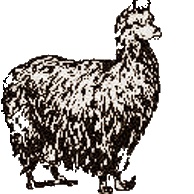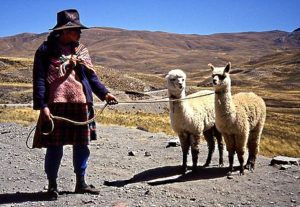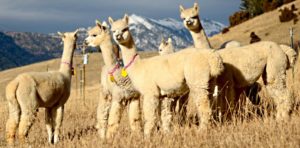
The Alpaca (Vicugna pacos) is a domesticated member of the South American camel (camelid) family developed from the wild alpaca. Other South American camelid species are the llama (Lama glama), vicuña (Vicugna vicugna) and guanaco (Lama guanicoe).
The main difference between alpacas and llamas is that llamas are much taller and bigger in proportion than alpacas, and that llamas have banana shaped ears. Alpacas have straight ears.
Alpacas are kept in herds that graze on the level heights of the Andes of Ecuador, southern Peru, northern Bolivia, and northern Chile at an altitude of 3500 to 5000 meters above sea-level, throughout the year. The alpaca is farmed in the greatest numbers on the Peruvian altiplano, or high plain, which is about 12,500 feet above sea level. The natural vegetation there is tussock grass, but some farmers have begun to improve the pasture to increase the productivity of their alpacas. Its thick wool coat enables it to survive in the below-freezing temperatures of these high plains.
The alpaca was first bred by the Incas about 500 B.C. and has been bred ever since for its wool, meat, skin, and milk. Its manure is used for fuel. Increasingly, however, the alpaca is being farmed purely as a wool producer. Peru supplies almost all of the world’s alpaca fiber, exporting 90 percent of it. The wool that is not exported is woven into ponchos, blankets, and rope.
Alpacas are considerably smaller than llamas and unlike them are valued mainly for their fiber, used for making knitted and woven items including blankets, sweaters, hats, gloves, scarfs, a wide variety of textiles and ponchos in South America, and sweaters, socks and coats in other parts of the world. The fiber comes in more than 52 natural colours as classified in Peru, 12 as classified in Australia/New Zealand and 22 as classified in America.
 First significant exports of alpacas from South America occurred in the late twentieth century, with substantial breeding herds now established in North America, Australia and New Zealand. There are currently more than three million alpacas, and their numbers are rising as interest in farming them grows.
First significant exports of alpacas from South America occurred in the late twentieth century, with substantial breeding herds now established in North America, Australia and New Zealand. There are currently more than three million alpacas, and their numbers are rising as interest in farming them grows.
Apart from the relative small number of full-time and large alpaca breeders in New Zealand, most animals are kept as a ‘lifestyle’ choice due to their adorable appearance, good character and relatively easy care.

